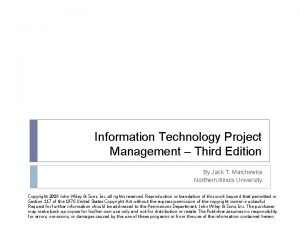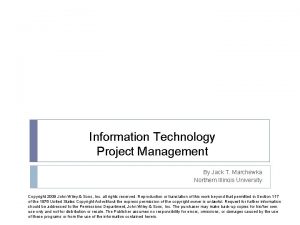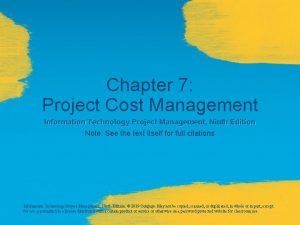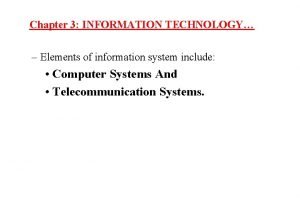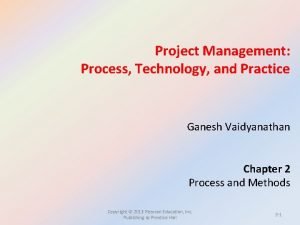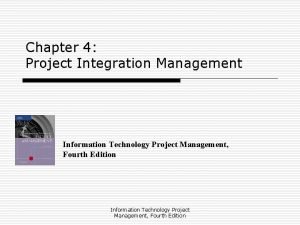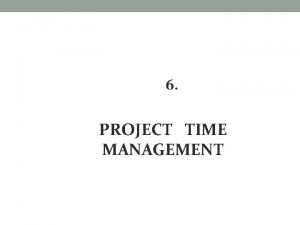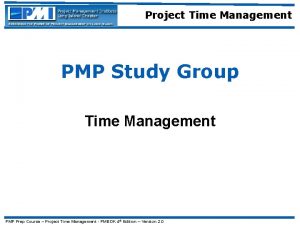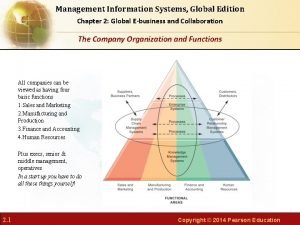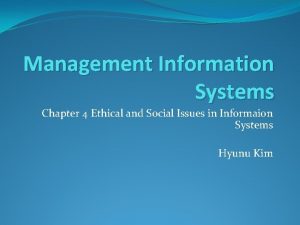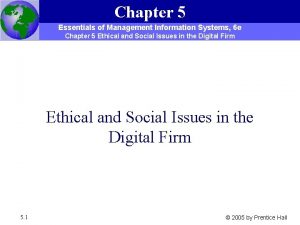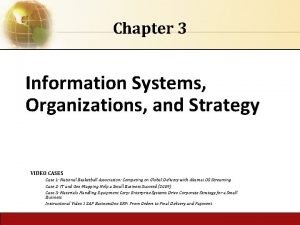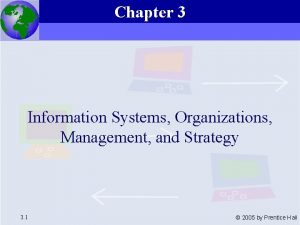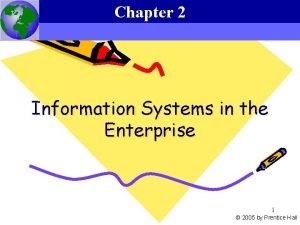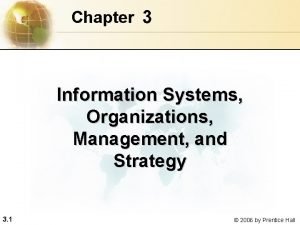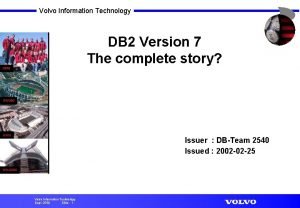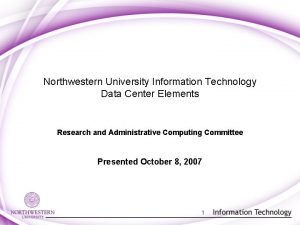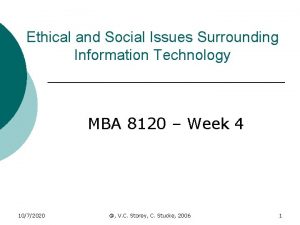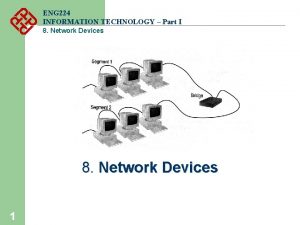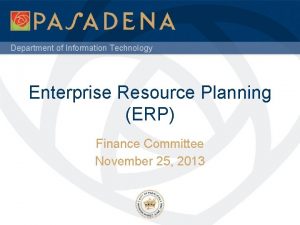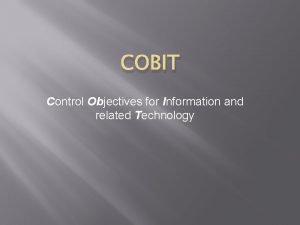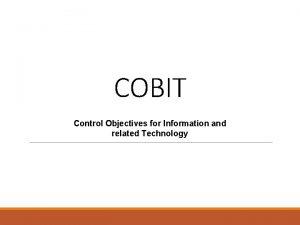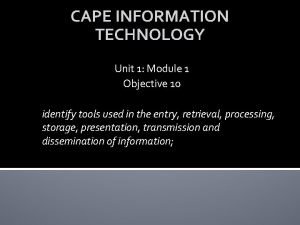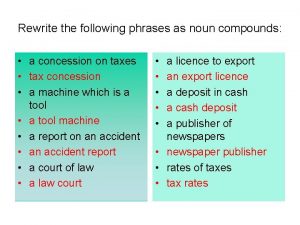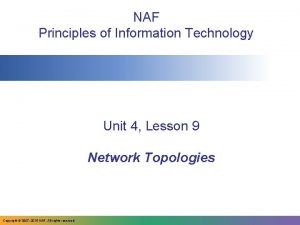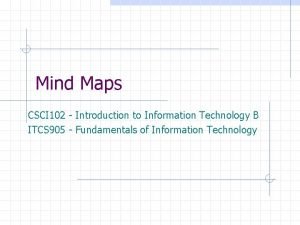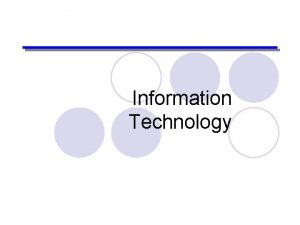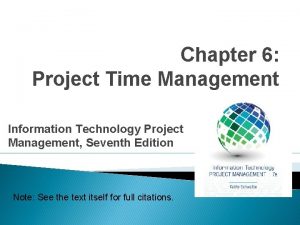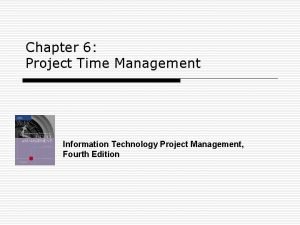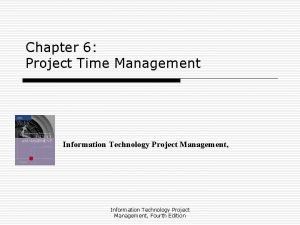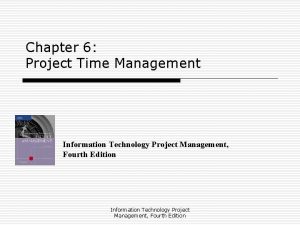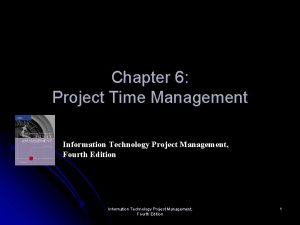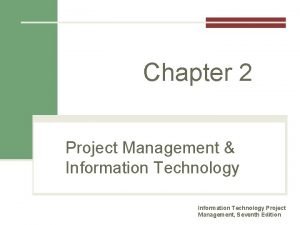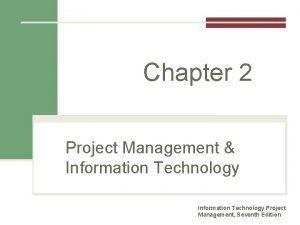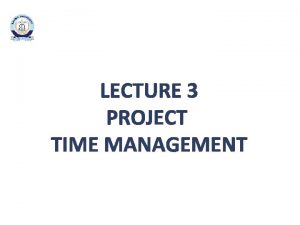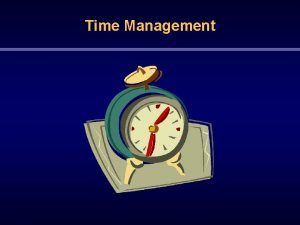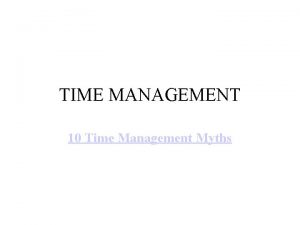Chapter 6 Project Time Management Information Technology Project

















































































- Slides: 81

Chapter 6: Project Time Management Information Technology Project Management, Fifth Edition

Importance of Project Schedules Managers often cite delivering projects on time as one of their biggest challenges Time has the least amount of flexibility; it passes no matter what happens on a project Schedule issues are the main reason for conflicts on projects, especially during the second half of projects 2 Project Time Management

Individual Work Styles and Cultural Differences Cause Schedule Conflicts One dimension of the Meyers-Briggs Type Indicator focuses on peoples’ attitudes toward structure and deadline Judgment type people prefer to follow schedules, meet deadlines and have closure. Perception types prefer to keep things open and flexible; deadlines are a signal to start rather than to complete a project Different cultures and even entire countries have different attitudes about schedules 3 Project Time Management

Media Snapshot In contrast to the 2002 Salt Lake City Winter Olympic Games, planning and scheduling was very different for the 2004 Summer Olympic Games held in Athens, Greece Many articles were written before the opening ceremonies predicting that the facilities would not be ready in time Many people were pleasantly surprised by the amazing opening ceremonies, beautiful new buildings, and state-ofthe-art security and transportation systems in Athens The Greeks even made fun of critics by having construction workers pretend to still be working as the ceremonies began 4 Project Time Management

Project Time Management Processes Activity definition: identifying the specific activities/tasks that the project team members and stakeholders must perform to produce the project deliverables Activity sequencing: identifying and documenting the relationships between project activities Activity resource estimating: estimating how many resources a project team should use to perform project activities Activity duration estimating: estimating the number of work periods that are needed to complete individual activities Schedule development: analyzing activity sequences, activity resource estimates, and activity duration estimates to create the project schedule Schedule control: controlling and managing changes to the project schedule 5 Project Time Management

Project Time Management Summary 6 Project Time Management

Activity Definition Project schedules grow out of the basic documents that initiate a project Project charter includes start and end dates and budget information Scope statement and WBS help define what will be done Activity definition involves developing a more detailed WBS and supporting explanations to understand all the work to be done so you can develop realistic cost and duration estimates 7 Project Time Management

Activity Definition The basis for creating a project schedule is derived from four project time management processes Activity definition – further defining the scope Activity sequencing – further defining the time Activity resource and activity duration (further defining the time and cost) 8 Project Time Management

Activity Lists and Attributes An activity list is a tabulation of activities to be included on a project schedule that includes: The activity name An activity identifier or number A brief description of the activity Activity attributes provide more information such as predecessors, successors, logical relationships, leads and lags, resource requirements, constraints, imposed dates, and assumptions related to the activity 9 Project Time Management

Milestones A milestone is a significant event that normally has no duration Not every deliverable or output created for a project is a milestone It often takes several activities and a lot of work to complete a milestone They’re useful tools for setting schedule goals and monitoring progress Examples include obtaining customer sign-off on key documents or completion of specific products such as software modules or the installation of new hardware 10 Project Time Management

What Went Wrong? At the U. S. Federal Bureau of Investigation (FBI), poor time management was one of the reasons behind the failure of Trilogy, a “disastrous, unbelievably expensive piece of vaporware, which was more than four years in the (un)making. The system was supposed to enable FBI agents to integrate intelligence from isolated information silos within the Bureau. ”* In May 2006, the Government Accounting Agency said that the Trilogy project failed at its core mission of improving the FBI’s investigative abilities and was plagued with missed milestones and escalating costs *Roberts, Paul, “Frustrated contractor sentenced for hacking FBI to speed deployment, ” Info. World Tech Watch, (July 6, 2006). 11 Project Time Management

Activity Sequencing After defining project activities, the next step is activity sequencing Involves reviewing the activity list and attributes, project scope statement, milestone list and approved change requests to determine the relationships between activities A dependency or relationship is the sequencing of project activities or tasks You must determine dependencies in order to use critical path analysis 12 Project Time Management

Three Types of Dependencies Mandatory dependencies: inherent in the nature of the work being performed on a project, sometimes referred to as hard logic Discretionary dependencies: defined by the project team; sometimes referred to as soft logic and should be used with care since they may limit later scheduling options Don’t start detailed design work until users sign-off on all the analysis – good practice but can delay project External dependencies: involve relationships between project and non-project activities Delivery of new hardware; if delayed can impact 13 project schedule Project Time Management

Network Diagrams Network diagrams are the preferred technique for showing activity sequencing A network diagram is a schematic display of the logical relationships among, or sequencing of, project activities Two main formats are the arrow and precedence diagramming methods 14 Project Time Management

Sample Activity-on-Arrow (AOA) Network Diagram for Project X 15 Project Time Management

Arrow Diagramming Method (ADM) Also called activity-on-arrow (AOA) network diagrams Activities are represented by arrows Nodes or circles are the starting and ending points of activities Can only show finish-to-start dependencies Can omit activities that have no dependencies 16 Project Time Management

Process for Creating AOA Diagrams 1. Find all of the activities that start at node 1: Draw their finish nodes and draw arrows between node 1 and those finish nodes; put the activity letter or name and duration estimate on the associated arrow 2. Continue drawing the network diagram, working from left to right: Look for bursts and merges Bursts occur when a single node is followed by two or more activities A merge occurs when two or more nodes precede a single node 17 3. Continue drawing the project network diagram until all activities are included on the diagram that have dependencies 4. As a rule of thumb, all arrowheads should face toward the right, and no arrows should cross on an AOA network diagram Project Time Management

Precedence Diagramming Method (PDM) More popular than ADM method and used by project management software Activities are represented by boxes Arrows show relationships between activities Better at showing different types of dependencies 18 Project Time Management

Task Dependency Types 19 Project Time Management

Sample PDM Network Diagram 20 Project Time Management

Activity Resource Estimating Before estimating activity durations, you must have a good idea of the quantity and type of resources that will be assigned to each activity Consider important issues in estimating resources How difficult will it be to do specific activities on this project? What is the organization’s history in doing similar activities? Are the required resources available or need to be acquired? A resource breakdown structure is a hierarchical structure that identifies the project’s resources by category and type 21 Project Time Management

Activity Duration Estimating Duration includes the actual amount of time worked on an activity plus elapsed time Effort is the number of workdays or work hours required to complete a task Effort does not normally equal duration People doing the work should help create estimates, and an expert should review them 22 Project Time Management

Three-Point Estimates Instead of providing activity estimates as a discrete number, such as four weeks, it’s often helpful to create a three-point estimate An estimate that includes an optimistic, most likely, and pessimistic estimate, such as three weeks for the optimistic, four weeks for the most likely, and five weeks for the pessimistic estimate Three-point estimates are needed for PERT and Monte Carlo simulations 23 Project Time Management

Schedule Development Uses results of the other time management processes to determine the start and end date of the project Ultimate goal is to create a realistic project schedule that provides a basis for monitoring project progress for the time dimension of the project Important tools and techniques include Gantt charts, critical path analysis, critical chain scheduling, and PERT analysis 24 Project Time Management

Gantt Charts Gantt charts provide a standard format for displaying project schedule information by listing project activities and their corresponding start and finish dates in a calendar format Symbols include: Black diamonds: milestones Thick black bars: summary tasks Lighter horizontal bars: durations of tasks Arrows: dependencies between tasks 25 Project Time Management

Figure 6 -5: Gantt Chart for Project X Note: Darker bars would be red in Project 2007 to represent critical tasks 26 Project Time Management

Gantt Chart for Software Launch Project 27 Project Time Management

Adding Milestones to Gantt Charts Many people like to focus on meeting milestones, especially for large projects Milestones emphasize important events or accomplishments on projects Normally create milestone by entering tasks with a zero duration, or you can mark any task as a milestone 28 Project Time Management

SMART Criteria Milestones should be: Specific Measurable Assignable Realistic Time-framed 29 Project Time Management

Best Practice Schedule risk is inherent in the development of complex systems Luc Richard, the founder of www. projectmangler. com, suggests that project managers can reduce schedule risk through project milestones, a best practice that involves identifying and tracking significant points or achievements in the project 30 Project Time Management

Best Practice (continued) The five key points of using project milestones include the following: 1. Define milestones early in the project and include them in the Gantt chart to provide a visual guide 2. Keep milestones small and frequent 3. The set of milestones must be all-encompassing 4. Each milestone must be binary, meaning it is either complete or incomplete 5. Carefully monitor the critical path 31 Project Time Management

Sample Tracking Gantt Chart 32 Project Time Management

Critical Path Method (CPM) CPM is a network diagramming technique used to predict total project duration A critical path for a project is the series of activities that determines the earliest time by which the project can be completed The critical path is the longest path through the network diagram and has the least amount of slack or float Slack or float is the amount of time an activity may be delayed without delaying a succeeding activity or the project finish date 33 Project Time Management

Calculating the Critical Path First develop a good network diagram Add the duration estimates for all activities on each path through the network diagram The longest path is the critical path If one or more of the activities on the critical path takes longer than planned, the whole project schedule will slip unless the project manager takes corrective action 34 Project Time Management

Determining the Critical Path for Project X 35 Project Time Management

More on the Critical Path A project team at Apple computer put a stuffed gorilla on the top of the cubicle of the person currently managing a critical task The critical path is not the one with all the critical activities; it only accounts for time Remember the example of growing grass being on the critical path for Disney’s Animal Kingdom There can be more than one critical path if the lengths of two or more paths are the same The critical path can change as the project progresses 36 Project Time Management

Using Critical Path Analysis to Make Schedule Trade-offs Free slack or free float is the amount of time an activity can be delayed without delaying the early start of any immediately following activities Total slack or total float is the amount of time an activity may be delayed from its early start without delaying the planned project finish date A forward pass through the network diagram determines the early start and finish dates A backward pass determines the late start and finish dates 37 Project Time Management

Calculating Early and Late Start and Finish Dates 38 Project Time Management

Free and Total Float or Slack for Project X 39 Project Time Management

How to Find the Critical Path General Foundry’s network with expected activity times A 2 C 2 F E 3 4 H Start 2 Finish B Figure 13. 3 3 D 4 G 5

How to Find the Critical Path 1. 2. 3. 4. To find the critical path, need to determine the following quantities for each activity in the network Earliest start time (ES): ES the earliest time an activity can begin without violation of immediate predecessor requirements Earliest finish time (EF): EF the earliest time at which an activity can end Latest start time (LS): LS the latest time an activity can begin without delaying the entire project Latest finish time (LF): LF the latest time an activity can end without delaying the entire project

How to Find the Critical Path In the nodes, the activity time and the early and late start and finish times are represented in the following manner ACTIVITY ES LS t EF LF Earliest times are computed as Earliest finish time = Earliest start time + Expected activity time EF = ES + t Earliest start = Largest of the earliest finish times of immediate predecessors ES = Largest EF of immediate predecessors

How to Find the Critical Path At the start of the project we set the time to zero Thus ES = 0 for both A and B A ES = 0 t=2 EF = 0 + 2 = 2 B ES = 0 t=3 EF = 0 + 3 = 3 Start

How to Find the Critical Path General Foundry’s ES and EF times A 0 2 2 C 2 2 4 F 4 E 4 Start B 0 Figure 13. 4 3 3 D 3 4 7 3 7 4 8 H 13 G 8 5 13 2 15 Finish

How to Find the Critical Path Latest times are computed as Latest start time = Latest finish time – Expected activity time LS = LF – t Latest finish time = Smallest of latest start times for following activities LF = Smallest LS of following activities For activity H LS = LF – t = 15 – 2 = 13 weeks

How to Find the Critical Path General Foundry’s LS and LF times A 0 0 2 2 2 C 2 2 2 4 4 F 4 10 E 4 4 Start B 0 1 Figure 13. 5 3 3 4 D 3 4 4 7 8 3 7 13 4 8 8 H 13 13 G 8 8 5 13 13 2 15 15 Finish

How to Find the Critical Path Once ES, LS, EF, and LF have been determined, it is a simple matter to find the amount of slack time that each activity has Slack = LS – ES, or Slack = LF – EF From Table 13. 3 we see activities A, C, E, G, and H have no slack time These are called critical activities and they are said to be on the critical path The total project completion time is 15 weeks Industrial managers call this a boundary timetable

How to Find the Critical Path General Foundry’s schedule and slack times ACTIVITY EARLIEST START, ES EARLIEST FINISH, EF LATEST START, LS LATEST FINISH, LF SLACK, LS – ES ON CRITICAL PATH? A 0 2 0 Yes B 0 3 1 4 1 No C 2 4 0 Yes D 3 7 4 8 1 No E 4 8 0 Yes F 4 7 10 13 6 No G 8 13 0 Yes H 13 15 0 Yes Table 13. 3

How to Find the Critical Path General Foundry’s critical path A 0 0 2 2 2 C 2 2 2 4 4 F 4 10 E 4 4 Start B 0 1 Figure 13. 6 3 3 4 D 3 4 4 7 8 3 7 13 4 8 8 H 13 13 G 8 8 5 13 13 2 15 15 Finish

Using the Critical Path to Shorten a Project Schedule Three main techniques for shortening schedules Shortening durations of critical activities/tasks by adding more resources or changing their scope Crashing activities by obtaining the greatest amount of schedule compression for the least incremental cost A 2 week task with one person working 50% could be shortened to 1 week if the person is assigned 100% no increase in cost Or, a temporary worker could be hired to work in parallel with the other worker to speed up the task (at a cost) 50

Project Crashing Projects will sometimes have deadlines that are impossible to meet using normal procedures By using exceptional methods it may be possible to finish the project in less time than normally required However, this usually increases the cost of the project Reducing a project’s completion time is called crashing

Project Crashing a project starts with using the normal time to create the critical path The normal cost is the cost for completing the activity using normal procedures If the project will not meet the required deadline, extraordinary measures must be taken The crash time is the shortest possible activity time and will require additional resources The crash cost is the price of completing the activity in the earlier-than-normal time

Four Steps to Project Crashing 1. Find the normal critical path and identify the critical activities 2. Compute the crash cost per week (or other time period) for all activities in the network using the formula Crash cost – Normal cost Crash cost/Time period = Normal time – Crash time

Four Steps to Project Crashing 3. 4. Select the activity on the critical path with the smallest crash cost per week and crash this activity to the maximum extent possible or to the point at which your desired deadline has been reached Check to be sure that the critical path you were crashing is still critical. If the critical path is still the longest path through the network, return to step 3. If not, find the new critical path and return to step 2.

General Foundry Example General Foundry has been given 14 weeks instead of 16 weeks to install the new equipment The critical path for the project is 15 weeks What options do they have? The normal and crash times and costs are shown in Table 13. 9 Crash costs are assumed to be linear and Figure 13. 11 shows the crash cost for activity B Crashing activity A will shorten the completion time to 14 but it creates a second critical path B, D, G, H because when you recalculate the LF and LS times for B and D they now match the EF and ES Any further crashing must be done to both critical paths

General Foundry Example Normal and crash data for General Foundry TIME (WEEKS) COST ($) ACTIVITY NORMAL CRASH COST PER WEEK ($) CRITICAL PATH? A 2 1 22, 000 23, 000 1, 000 Yes B 3 1 30, 000 34, 000 2, 000 No C 2 1 26, 000 27, 000 1, 000 Yes D 4 3 48, 000 49, 000 1, 000 No E 4 2 56, 000 58, 000 1, 000 Yes F 3 2 30, 000 30, 500 No G 5 2 80, 000 86, 000 2, 000 Yes H 2 1 16, 000 19, 000 3, 000 Yes Table 13. 9

General Foundry Example Crash and normal times and costs for activity B Activity Cost Crash Cost/Week = $34, 000 – Crash Cost – Normal Cost Normal Time – Crash Time $34, 000 – $30, 000 3– 1 $4, 000 = = $2, 000/Week 2 Weeks $33, 000 – = $32, 000 – $31, 000 – Normal $30, 000 – Normal Cost – | 0 Figure 13. 11 | 1 Crash Time | 2 | 3 Normal Time (Weeks)

Using the Critical Path to Shorten a Project Schedule Fast tracking activities by doing them in parallel or overlapping them instead of doing them in sequence Instead of waiting for all analysis to be completed before starting coding, some coding could begin for those tasks that have been fully analyzed Drawback – starting a task too soon could lengthen the project because other tasks whose analysis has not been completed could impact this task and cause rework 58 Project Time Management

Importance of Updating Critical Path Data It is important to update project schedule information to meet time goals for a project The critical path may change as you enter actual start and finish dates If you know the project completion date will slip, be proactive and negotiate with the project sponsor and stakeholders 59 Project Time Management

Critical Chain Scheduling Critical chain scheduling A method of scheduling that considers limited resources when creating a project schedule and includes buffers to protect the project completion date Based on the Theory of Constraints (TOC) A management philosophy developed by Eli Goldratt and introduced in his book The Goal and Critical Chain Like a chain with its weakest link, any complex system at any point in time often has only one aspect or constraint that limits ability to achieve more of its goal For the system to attain any significant improvements, that constraint must be identified and the whole system must be managed with it in mind For example, two tasks originally scheduled to be done in parallel, require the same resource 100% of the time. CCS acknowledges that either one of the tasks must be delayed or a similar resource must be found in order to keep to the original schedule 60 Project Time Management

Critical Chain Scheduling Attempts to minimize multitasking When a resource works on more than one task at a time – people are assigned to multiple tasks within the same project or different tasks on multiple projects Someone assigned to three tasks, tries to please everyone and works a little on each task and then goes back to finish the first one This can actually delay the completion of tasks as compared to working on each task in sequence Multitasking also often involves wasted setup time, which increases total duration 61 Project Time Management

Multitasking Example 62 Project Time Management

Critical Chain Scheduling Critical Chain Project Management (CCPM), developed by Eliyahu M. Goldratt, is a method of planning and managing projects that puts more emphasis on the resources required to execute project tasks. This is in contrast to the more traditional Critical Path and PERT methods, which emphasize task order and rigid scheduling. A Critical Chain project network will tend to keep the resources levelly loaded, but will require them to be flexible in their start times and to quickly switch between tasks and task chains to keep the whole project on schedule. Typically, CCPM case studies report 95% on-time and on- budget completion when CCPM is applied correctly. 63 Project Time Management

Buffers and Critical Chain In traditional estimates, people often add a buffer to each task and use it if it’s needed or not A buffer is additional time to complete a task This time is added to when there is multitasking, distractions, interruptions, fear that estimates will be reduced and Murphy’s Law states that if something can go wrong, it will 64 Project Time Management

Buffers and Critical Chain Critical chain scheduling removes buffers from individual tasks and instead creates: A project buffer or additional time added before the project’s due date Feeding buffers or additional time added before tasks on the critical path that are preceded by non-critical-path tasks The tasks estimates in critical chain scheduling should be shorter than traditional estimates because they do not include their own buffers Not having tasks buffers should mean less occurrence of Parkinson’s Law - work expands to fill the time allowed Feeding and project buffers protect the date that really needs to be met – the project completion date 65 Project Time Management

Example of Critical Chain Scheduling 66 Project Time Management

Example of Critical Chain Scheduling Critical Path = Task 1+Task 2+Task 3+ Lag+ Task 6 = 5+4+2+1+8 = 21 Days. 67 Project Time Management

Example of Critical Chain Scheduling Critical Path = Task 1+Task 2+Task 3+ Lag+ Task 6 = 5+4+2+1+8 = 21 Days. 68 Project Time Management

Example of Critical Chain Scheduling 69 Remove safety time and reduce tasks durations by 50%. Project Duration = Task 1+Task 2+Task 3+ Task 6 = 3+2+1+4 = 10 Days. Note: • All safety time durations are removed. For example 1 day lag after Task 2 and 4 days after Task 5 are removed. • All tasks durations are reduced to half (50%). For example Task 1 is 3 Days instead of 6 days. Project Time Management

Example of Critical Chain Scheduling 70 Create schedule on Late Finish dates and Remove resource constraints and identify critical chain. Project Duration = Task 1+Task 2+Task 5+ Task 6 = 3+2+2+4 = 11 Days. Note: • Task 3, Task 4 and Task 5 are moved to start from Late Finish dates. • Task 2 and Task 5 are to be done by resource R 2 and so that aligned to remove resource constraints. Project Time Management

Example of Critical Chain Scheduling Add Project Buffer of 50% of the tasks duration and add Feeder buffer to non critical chain. Project Duration = Task 1+Task 2+Task 5+ Task 6 + PB = 3+2+2+4+5 = 16 Days. Note: • Project Buffer (PB) = 50% of Project Duration (11 Days) = 5. 5 Days = 5 Days (Rounded). • Feeder Buffer (FB) for non critical tasks on chain. For example Task 4 is added 2 days FB. 71 Project Time Management

Comparison of CPM and CCPM results According to the results we found above, project duration by CPM traditional approach is 21 days and the project duration for the same amount of work by using CCPM is 16 Days. Using CCPM: Project Duration can be reduced by 25 -40%. Resources can be utilized effectively. Project is fully focused on both critical and non critical tasks

Program Evaluation and Review Technique (PERT) PERT is a network analysis technique used to estimate project duration when there is a high degree of uncertainty about the individual activity duration estimates PERT uses probabilistic time estimates Duration estimates based on using optimistic, most likely, and pessimistic estimates of activity durations, or a three-point estimate PERT attempts to address the risk associated with duration estimates by developing schedules that are more realistic It involves more work than CPM since it requires several duration estimates 73 Project Time Management

PERT Formula and Example PERT weighted average = optimistic time + 4 X most likely time + pessimistic time 6 Example: PERT weighted average = 8 workdays + 4 X 10 workdays + 24 workdays = 12 days 6 where optimistic time= 8 days, most likely time = 10 days, and pessimistic time = 24 days Therefore, you’d use 12 days on the network diagram instead of 10 when using PERT for the above example 74 Project Time Management

Schedule Control Perform reality checks on schedules Allow for contingencies Don’t plan for everyone to work at 100% capacity all the time Hold progress meetings with stakeholders and be clear and honest in communicating schedule issues 75 Project Time Management

Schedule Control (continued) Goals are to know the status of the schedule, influence factors that cause schedule changes, determine that the schedule has changed, and manage changes when they occur Tools and techniques include: Progress reports A schedule change control system Project management software, including schedule comparison charts like the tracking Gantt chart Variance analysis, such as analyzing float or slack Performance management, such as earned value (chapter 7) 76 Project Time Management

Reality Checks on Scheduling First review the draft schedule or estimated completion date in the project charter Prepare a more detailed schedule with the project team Make sure the schedule is realistic and followed Alert top management well in advance if there are schedule problems Verify schedule progress – just because a team member says a task was completed on time doesn’t always mean that it was 77 Project Time Management

Working with People Issues Strong leadership helps projects succeed more than good PERT charts Project managers should use: Empowerment Incentives Discipline Negotiation 78 Project Time Management

What Went Right? Chris Higgins used the discipline he learned in the U. S. Army to transform project management into a cultural force at Bank of America; he used the same approach he did for packing tents when he led an interstate banking initiative He made the team members analyze, plan, and document requirements for the system in such detail that it took six months just to complete that phase However, because of his discipline with time management and planning, the software developers on the team finished all of the coding in only three months, and the project was completed on time* *Melymuke, Kathleen, “Spit and Polish, ” Computer. World (February 16, 1998). 79 Project Time Management

Using Software to Assist in Time Management Software for facilitating communications helps people exchange schedule-related information Decision support models help analyze trade-offs that can be made Project management software can help in various time management areas 80 Project Time Management

Words of Caution on Using Project Management Software Many people misuse project management software because they don’t understand important concepts and have not had training You must enter dependencies to have dates adjust automatically and to determine the critical path You must enter actual schedule information to compare planned and actual progress 81 Project Time Management
 Information technology project management 9th edition
Information technology project management 9th edition Blue project chapter 5
Blue project chapter 5 Information technology project management 8th edition
Information technology project management 8th edition Information technology project management 9th edition
Information technology project management 9th edition Information technology project management 9th edition
Information technology project management 9th edition Information technology project management
Information technology project management Information technology project management
Information technology project management Traditional project management vs modern project management
Traditional project management vs modern project management Definitive estimate range
Definitive estimate range Enterprise and global management of information technology
Enterprise and global management of information technology Information technology resource management
Information technology resource management Information technology and customer relationship management
Information technology and customer relationship management Information technology chapter 3
Information technology chapter 3 Chapter 1 information technology the internet and you
Chapter 1 information technology the internet and you Chapter 1 information technology the internet and you
Chapter 1 information technology the internet and you What is elapsed time
What is elapsed time Project management process technology and practice
Project management process technology and practice Project management for information security
Project management for information security Project management information system example
Project management information system example Project management information system example
Project management information system example Time management project
Time management project Pmp time management
Pmp time management Pmbok time management
Pmbok time management Crash time in project management
Crash time in project management Time management in human resource management
Time management in human resource management Management information system chapter 2
Management information system chapter 2 Management information system chapter 3
Management information system chapter 3 Mis chapter 4
Mis chapter 4 Function of information system with diagram
Function of information system with diagram Chapter 9 information management and security
Chapter 9 information management and security Management information system chapter 5
Management information system chapter 5 Management information system chapter 5
Management information system chapter 5 Introduction management information system
Introduction management information system Mis chapter 5
Mis chapter 5 Management information system chapter 3
Management information system chapter 3 Management information system chapter 3
Management information system chapter 3 Management information system chapter 2
Management information system chapter 2 Chapter 15 using management and accounting information
Chapter 15 using management and accounting information Management information system chapter 3
Management information system chapter 3 The role of project management in achieving project success
The role of project management in achieving project success Modern process transitions in spm
Modern process transitions in spm When reducing project duration
When reducing project duration Introduction to project management kathy schwalbe
Introduction to project management kathy schwalbe Project evaluation in software project management
Project evaluation in software project management When conducting post project audits
When conducting post project audits Ms project agile
Ms project agile Types of project termination in project management
Types of project termination in project management Materials technology positive impacts
Materials technology positive impacts Negative effects of technology on environment
Negative effects of technology on environment Volvo information technology ab
Volvo information technology ab User acceptance of information technology
User acceptance of information technology Conclusion
Conclusion Media literacy and information literacy similarities
Media literacy and information literacy similarities Northwestern mailroom
Northwestern mailroom 5 disadvantages of information technology
5 disadvantages of information technology Introduction to information technology
Introduction to information technology Luqman long
Luqman long History of information technology
History of information technology Fluency with information technology
Fluency with information technology Issues surrounding information privacy
Issues surrounding information privacy Bridge information technology
Bridge information technology Erp information technology
Erp information technology Current and future trends of media and information essay
Current and future trends of media and information essay Cobit control objectives
Cobit control objectives Control objectives for information and related technology
Control objectives for information and related technology Auditing information technology
Auditing information technology Cape information technology unit 1 notes
Cape information technology unit 1 notes Btec first engineering teaching and assessment pack
Btec first engineering teaching and assessment pack Accounting information technology and business solutions
Accounting information technology and business solutions Importance of information technology in daily life
Importance of information technology in daily life Flowchart analisis sistem
Flowchart analisis sistem Courseweb.sliit.lk
Courseweb.sliit.lk Compound noun phrases
Compound noun phrases Information technology unit 4
Information technology unit 4 Information technology mind map
Information technology mind map Components of mil
Components of mil An act of transmitting messages
An act of transmitting messages Head of information technology
Head of information technology Information technology assessment
Information technology assessment Technology big picture
Technology big picture Workshop security awareness
Workshop security awareness Information processes and technology past papers
Information processes and technology past papers





